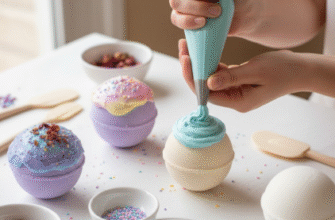Tired of scanning lengthy ingredient lists on toothpaste tubes? Maybe you’re looking to reduce plastic waste or simply prefer a more natural approach to your daily routines. Whatever your reason, crafting your own tooth powder is a surprisingly simple and rewarding endeavor. It allows you complete control over what goes into your mouth, leaning on ingredients that have been used for oral care in various forms for generations. Forget the foaming agents and artificial sweeteners; let’s explore how you can mix up a batch of personalized tooth powder right in your kitchen.
Understanding the Basics: Core Ingredients
Most natural tooth powder recipes revolve around a few key components that act as gentle abrasives, cleansers, and fresheners. Getting familiar with these building blocks is the first step to creating your perfect blend.
Baking Soda (Sodium Bicarbonate)
This common household item is a star player in many DIY tooth powder recipes. It’s a very mild abrasive, helping to gently lift surface stains and plaque from teeth. Its alkaline nature can also help neutralize acids in the mouth produced by bacteria, which contribute to tooth decay. Many people find it leaves their mouth feeling exceptionally clean. However, some find the taste slightly salty, which is why it’s often combined with other ingredients.
Bentonite Clay
A powerhouse ingredient, bentonite clay is known for its detoxifying properties. When hydrated, it develops an electrical charge that can help bind to toxins and impurities. In tooth powder, it acts as a gentle cleanser and polisher. It’s rich in minerals like calcium and magnesium, which are theoretically beneficial for teeth, though direct remineralization from topical application is debated. Crucially, always use food-grade bentonite clay to ensure it’s free from contaminants.
Sea Salt
Finely ground sea salt adds trace minerals and has natural cleansing and antibacterial properties. It can help stimulate saliva production, which is the mouth’s natural defense mechanism. Use very fine salt to avoid excessive abrasion. Some people prefer Himalayan pink salt for its mineral profile, but any high-quality, finely ground sea salt works well.
Optional Additions: Customizing Your Powder
Once you have your base, you can add other ingredients for flavor, enhanced cleaning, or specific properties. This is where you can truly personalize your powder.
Xylitol
If the salty taste of baking soda or clay isn’t appealing, xylitol is a natural sweetener derived from plants (often birch or corn). Unlike sugar, xylitol doesn’t feed harmful mouth bacteria. In fact, studies suggest it can help inhibit the growth of Streptococcus mutans, a key bacteria associated with cavities. It adds a pleasant sweetness, making the powder more palatable, especially for those new to DIY oral care. Ensure you use a finely powdered form.
Herbs and Spices
Finely ground herbs and spices can add flavor and beneficial properties:
- Mint (Peppermint or Spearmint): Provides the classic fresh taste and breath-freshening qualities. Use dried, finely powdered leaves.
- Clove: Known for its antiseptic and mild numbing properties (historically used for toothaches). Has a strong, distinct flavor, so use sparingly. Must be finely ground.
- Cinnamon: Offers antibacterial properties and a warm, pleasant flavor.
- Sage: Traditionally used for gum health and oral cleansing.
Ensure any herbs used are ground to a very fine powder to avoid a gritty texture.
Essential Oils (Use with Caution)
A drop or two of certain essential oils can add potent flavor and antimicrobial benefits. Peppermint, spearmint, tea tree (use very little, it’s strong!), or cinnamon leaf oil are popular choices. However, essential oils are highly concentrated. Always use food-grade oils suitable for internal use (even though you spit out the powder), dilute them properly within the powder mixture, and use only 1-3 drops per batch initially. Some individuals may be sensitive to essential oils.
Important Considerations Before You Start: Natural doesn’t always mean harmless. Baking soda and clays can be abrasive if used too vigorously or if your enamel is already compromised. Always use gentle pressure when brushing. It’s wise to do a patch test on your skin before using ingredients like essential oils orally. If you have sensitive teeth, gum disease, or any dental concerns, consult your dentist before switching your oral care routine.
Simple Natural Tooth Powder Recipes
Here are a few basic recipes to get you started. Feel free to adjust ratios based on your preferences. Always mix ingredients thoroughly in a clean, dry bowl.
Recipe 1: The Basic Clean
- 2 tablespoons Baking Soda
- 1 tablespoon Bentonite Clay (food-grade)
- 1/2 teaspoon Fine Sea Salt
This is a straightforward, effective powder focusing on core cleansing ingredients.
Recipe 2: Sweet & Fresh
- 1 tablespoon Baking Soda
- 1 tablespoon Bentonite Clay (food-grade)
- 1 tablespoon Powdered Xylitol
- 1/2 teaspoon Finely Powdered Mint Leaves (optional)
- 1-2 drops Peppermint Essential Oil (food-grade, optional)
The xylitol balances the saltiness and adds potential anti-cavity benefits. The mint provides familiar freshness.
Recipe 3: Mineral Rich Blend
- 2 tablespoons Bentonite Clay (food-grade)
- 1 tablespoon Calcium Carbonate Powder (food-grade, optional gentle abrasive/mineral source)
- 1/2 teaspoon Fine Sea Salt
- 1/4 teaspoon Finely Ground Clove Powder (optional)
This recipe emphasizes clay and optional calcium carbonate for a mineral-focused clean.
Mixing and Storing Your Tooth Powder
Use non-metallic utensils and bowls when working with bentonite clay, as metal can potentially reduce its effectiveness. A glass or ceramic bowl and a wooden or plastic spoon are ideal.
Combine all your chosen dry ingredients in the bowl. If using essential oils, add the drops and mix extremely well to ensure they are evenly distributed throughout the powder. Break up any clumps.
Store your finished tooth powder in a small, airtight glass jar with a non-metallic lid. Keep it in a cool, dry place like your bathroom cabinet. Avoid getting water into the container, as this can introduce bacteria and spoil the powder. Proper storage should keep it fresh for several months.
How to Use Your Homemade Tooth Powder
Using tooth powder is slightly different from using paste, but just as easy:
- Wet your toothbrush bristles lightly.
- Tap off any excess water. You want the brush damp, not dripping.
- Dip the damp bristles lightly into the tooth powder jar, picking up a small amount. Alternatively, sprinkle a little powder onto the brush or into the palm of your hand and dip the brush there to avoid contaminating the main jar.
- Brush your teeth gently as you normally would, covering all surfaces.
- Rinse your mouth thoroughly with water.
You’ll notice it doesn’t foam like commercial toothpaste – this is normal! The cleaning action comes from the gentle abrasion and properties of the ingredients themselves, not from foaming agents like sodium lauryl sulfate (SLS).
Verified Tip: To avoid introducing moisture or bacteria into your main supply of tooth powder, consider decanting a small amount into a separate tiny container for daily use. This way, you only dip your brush into the smaller portion. Refill the small container from your main jar as needed.
Embracing the Natural Shift
Switching to homemade tooth powder can be a fulfilling part of a more natural lifestyle. It connects you more closely to the products you use daily and simplifies your routine. Remember that consistency and gentle brushing technique are key, regardless of what product you use. Experiment with different ingredient ratios and additions until you find the blend that leaves your mouth feeling clean, fresh, and happy. Enjoy the process of creating something uniquely yours for your oral care!








